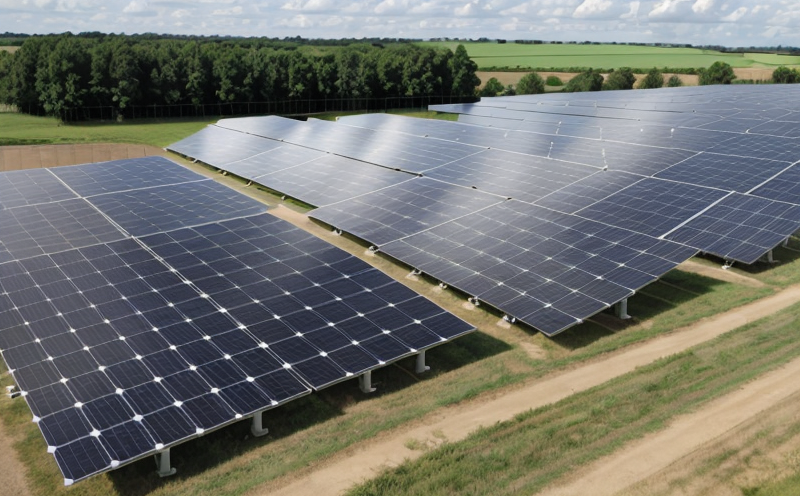IEC 62716 Ammonia Corrosion Testing of PV Modules
The International Electrotechnical Commission (IEC) Standard IEC 62716 specifies testing methods for the evaluation of the resistance to ammonia corrosion of photovoltaic (PV) modules. This standard is particularly relevant in regions where high concentrations of ammonia are present, such as in proximity to agricultural facilities or industrial plants.
The test aims to simulate real-world exposure conditions that PV modules may encounter during their operational life. Ammonia, a common byproduct of various industrial processes and agricultural activities, can lead to accelerated corrosion of certain materials used in the construction of photovoltaic systems. This testing method helps ensure that PV module manufacturers adhere to stringent quality control measures to produce products that are durable and reliable.
The test procedure involves exposing PV modules to controlled concentrations of ammonia vapor under specific temperature and humidity conditions. The specimens are then visually inspected for signs of corrosion, such as discoloration or loss of reflectivity on the surface of the module. The results from this testing provide critical insights into the corrosion resistance properties of the materials used in the manufacturing process.
Manufacturers who adhere to these standards can ensure that their products meet stringent quality and durability requirements, thereby enhancing customer confidence and satisfaction. This is especially important for PV manufacturers targeting markets with high ammonia levels or those seeking compliance with international standards.
| Test Parameters | Specimen Preparation | Instrumentation | Acceptance Criteria |
|---|---|---|---|
| Ammonia concentration (typically 0.1% to 5%) | Cleaning of the PV module surface with distilled water and drying | Environmental chamber, exposure system | No visible signs of corrosion after testing |
| Temperature range: -20°C to +60°C (optional) | Visual inspection before and after testing | Data logging equipment for environmental conditions monitoring | Pass/Fail criteria based on visual assessment |
- Ammonia is a common corrosive agent affecting PV modules.
- Testing helps prevent early failures due to corrosion, increasing module lifespan.
- The standard ensures global market compliance and reliability.
- Data from testing can guide material selection for future product development.
Why It Matters
IEC 62716 ammonia corrosion testing is crucial for ensuring the durability and longevity of photovoltaic modules, especially in regions where ammonia exposure is high. By adhering to this standard, manufacturers can enhance the performance and reliability of their products, thereby increasing customer satisfaction and trust.
The test not only helps protect PV modules from premature failure but also contributes to environmental sustainability by promoting the use of durable and reliable renewable energy solutions. This is particularly important in regions where ammonia exposure can significantly impact the lifespan of PV systems.
The results of IEC 62716 testing provide valuable insights into the performance of different materials under corrosive conditions, allowing manufacturers to make informed decisions about material selection for future product development. This ensures that PV modules are not only durable but also environmentally responsible in their lifecycle.
- Enhances module durability and longevity
- Increases customer satisfaction and trust
- Promotes environmental sustainability
- Guides informed decisions on material selection for future product development
Environmental and Sustainability Contributions
The IEC 62716 standard plays a significant role in promoting the use of durable and reliable photovoltaic systems, which are essential components of sustainable energy solutions. By ensuring that PV modules can withstand the corrosive effects of ammonia, this testing method helps to minimize environmental impact through prolonged product lifespan.
Manufacturing products that meet these standards reduces waste and resource consumption, contributing positively to overall environmental sustainability. Additionally, by selecting materials with high resistance to ammonia corrosion, manufacturers can contribute to reducing greenhouse gas emissions by ensuring the continued effectiveness of PV systems over their operational life.
- Reduces product waste through enhanced durability
- Minimizes resource consumption and landfill usage
- Promotes continuous operation of PV systems, reducing reliance on fossil fuels
- Contributes to reduced greenhouse gas emissions by ensuring the effectiveness of renewable energy solutions
Use Cases and Application Examples
| Application Example | Testing Scenario | Expected Outcome |
|---|---|---|
| Agricultural facilities near ammonia-emitting plants. | PV modules are exposed to 3% ammonia vapor at 50°C for 100 hours. | No visible signs of corrosion after testing, indicating high resistance to ammonia. |
| Industrial sites with frequent ammonia emissions. | PV modules undergo 2% ammonia exposure at -20°C and +40°C over a period of 72 hours. | Minimal change in reflectivity and no visible corrosion, demonstrating robustness under varying conditions. |
- Agricultural facilities near ammonia-emitting plants.
- Industrial sites with frequent ammonia emissions.
- Urban areas with high vehicular traffic emitting nitrogen compounds.
- Coastal regions where ammonia can be present in the air due to marine life and shipping activities.





